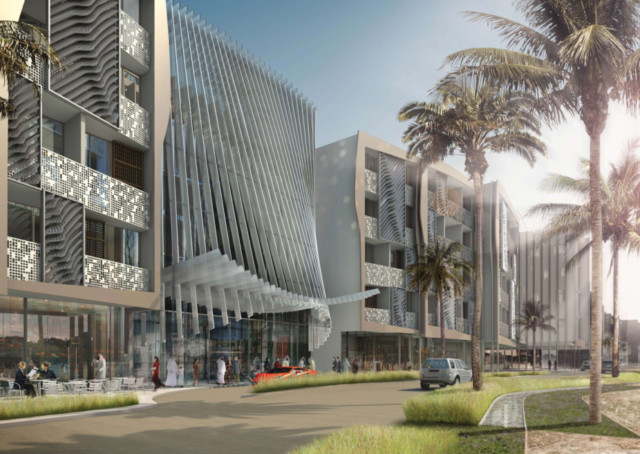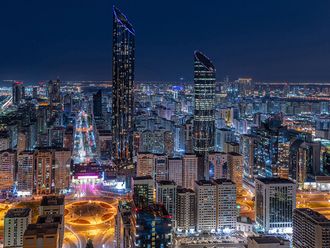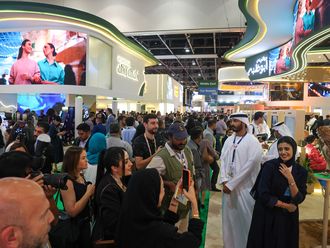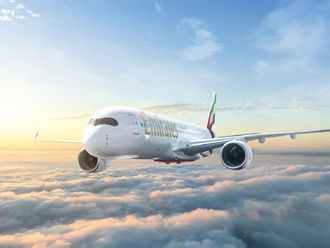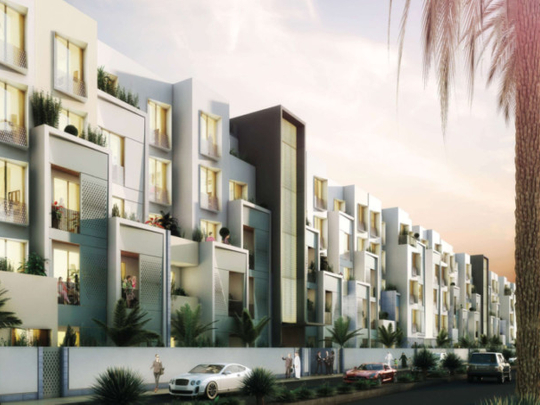
Developed in one of Dubai’s more pricey residential locations, Mirdif Hills offers homes with a new twist: villas built on top of each other. The innovative residential concept is everything a villa should be, except that the homes are built within low-rise buildings.
While the developer, Dubai Investment Real Estate Company (DIRC), a subsidiary of Dubai Investments, aims to generate attention with the novel concept, Mirdif Hills is also grabbing the limelight for putting Mirdif in the freehold conversation.
“This is a mid-market project. We tried to cover as much of the market as possible, but land prices are not cheap in Mirdif — no less than Dh400 and up to Dh1,000 [per square foot],” explains Khalid Bin Kalban, managing director and CEO of Dubai Investments and Chairman of DIRC and Union Properties (UP). “To give you an idea of values [in Mirdif], UP recently [sold] 9-10 year-old units in the area at Dh1,350 to Dh1,400 [per square foot].”
The 4-million-sq-ft freehold development, which was launched for sale in December, offers a mix of studio to three-bedroom residences at around Dh1,150 to Dh1,400 per square foot, or around Dh3.2 million for a villa and Dh1.6 million for an apartment. Land prices in Mirdif, much like those in prime neighbourhoods such as Jumeirah, are on the higher end. According to Iseeb Rehman, CEO of Sherwoods, the project’s sales agent, a typical villa plot in the area could cost Dh450-Dh600 per square foot.
“Mirdif Hills has low-rise buildings, G+4, so you can’t optimise pricing by going high,” says Rehman. “It may seem a bit pricey to some people, but it is actually great value for money in terms of the location.”
Half of the price is due during construction with the remainder upon handover. The developer has partnered with First Gulf Bank and Dubai Islamic Bank to offer mortgage to buyers.
“The development appeals to permanent residents already living in the area, mainly British and GCC nationals buying for their siblings,” says Rehman. “It’s a great first-time home. The entire master community is designed for owner-occupiers rather than investors. So far pretty much 75 per cent of the purchases are end users.”
The Dh3-billion project bordering Mushrif Park has been designed for families, with play areas, pools, linear gardens and boardwalks stimulating a pedestrian lifestyle. There are more than 50 retail units, including cafés, around the residential buildings and piazzas, as well as a four-star hotel and serviced apartments to be managed by Millennium, and a hospital to be leased for 20 years to NMC. The hotel and hospital will be ready by the second quarter of 2019, while most of the 1,054 residential units are slated for completion by the end of next year.
“We have started construction and EEC has mobilised as the contractor,” says Bin Kalban. “Funding for the project’s construction is secured, 20 per cent will come from us. And we have a plan B rather than relying on sales to fund Dh1.1 billion for the construction via secured lending from FGB and ADCB, which will be released in tranches.”
The developer will also build a power sub-station, as well as a district cooling plant under a Dubai Investments subsidiary, Emicool, which is already serving DIP and Dubai Motor City.
Bin Kalban also says that service charges will be within standard market rates, although he declined to provide figures.
Stacked villa buildings
Mirdif Hills’ master plan features three distinct areas. Al Multaqa Avenue houses the hospitality components as well as some 300 smaller residential units such as studios and one-bedroom apartments. The modern building blocks in Janayen and Nasayem Avenues will comprise buildings featuring the vertical villa concept of Swiss-born French architect Le Corbusier.
Some buildings will have conventional two- and three-bedroom apartments, while others will have duplex three– and four-bedroom villas stacked on top of each other, with an apartment crowning the top floor.
The design offers additional privacy to residents. “The quirkiness with this scheme is that you have four steps going up to your terrace, meaning from ground level to your garden you are eight feet higher,” explains Iseeb Rehman. “So someone walking on the street can’t see you on your terrace, which is itself large averaging 500 sq ft. Some units have up to 800 sq ft of terraces.
“The linear apartments on top also come with a quirk: you can easily take several units and make them into one.”
Another interesting design feature is the layout, which allows for cross ventilation, which helps improve the cooling effect of the residences. “Vertical villas are the trend going forward,” says Bin Kalban. “The main advantage in our project is that you have excellent views, besides the amenities of course, and the location.
“There are so many new things opening in the area, the safari and crocodile parks, an astronomy centre, a shooting club, cycling trails and Meraas is building a new edition of City Walk around 3km away from us.”
Market outlook
According to Khalid Bin Kalban things are going to move positively for the real estate market. “Of course, there are security concerns and restrictions on people coming in and out. Once that’s over, we’ll face a boom in real estate.”
Acknowledging the impact of oil prices in real estate, he also believes that oil prices will hover between $50 and $60 for some time, seeing no potential catalyst for a sudden hike. “The sentiment may not be here yet. Many are still waiting for the right time to buy, thinking the price will go down further, but we don’t share that view,” he says. “The market in general is stable and prices will increase soon. Yes, there are value and rent corrections in some areas, but in others they are increasing.”
Although he concedes that competition can be tough, he also points out that opportunities lie in the niches. “On the macro level you may feel there is a mismatch in supply and demand, but in reality it isn’t — major developers are announcing projects and are selling,” says Bin Kalban. “Demand and supply have almost stabilised, and our project is in niche market that is very needed in Mirdif.
“Dubai has different markets. There is a lot of investment in Dubai South, which 10-15 years from today will witness the same boom that other areas have seen before, so in the long run you will definitely make good money on your investments.”



